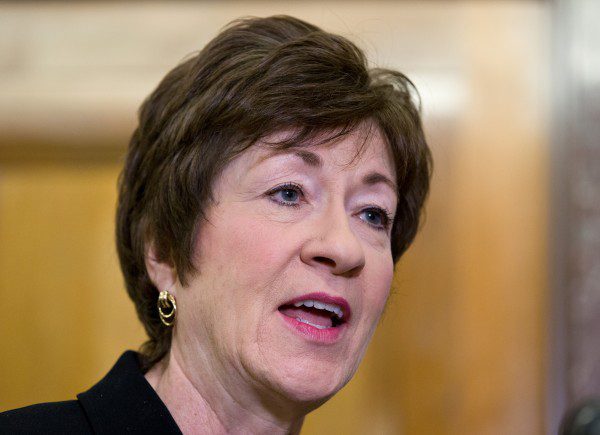If a railroad spilled thousands of gallons of oil in Maine, no one in the state — or in Washington — knows what the railroads would do or if they’re prepared for such a disaster.
In interviews with members of Maine’s congressional delegation, each said that’s the reason they are pushing federal regulators to strengthen planning, response and mitigation requirements for railroads that transport hazardous materials such as highly flammable crude oil.
“If the department does not come up with sufficient rules, I would not hesitate to pursue this further,” said Republican Sen. Susan Collins, a ranking member of the Senate appropriations subcommittee that oversees railroad safety.

This year, U.S. freight railroads are expected to carry 650,000 carloads of crude oil — up from just 9,500 in 2008, according to a Congressional Research Service report. After a four-month lull, highly flammable crude oil from the Bakken shale region of North Dakota is again traveling over Maine’s rail lines, and state safety officials know little about any hazardous materials coming by rail through communities.
“We’re sort of playing catch up in how it’s regulated and how we protect ourselves,” said Independent Senator Angus King. “It’s happened so fast.”
King said he is unsure whether a recent emergency order requiring railroads to notify the local communities through which they transport at least a million gallons of Bakken crude oil “went far enough.”
Oil spill clean-up funds in states like Maine, which has a three-cent-per-barrel fee on crude and refined oil that comes into the state, could be a model for a federal fund that goes toward emergency preparedness needs like training and equipment, said King.
“We know where these rails run, know what towns they run through – that’s where we should concentrate our efforts,” he said.
Democratic Reps. Mike Michaud and Chellie Pingree together introduced legislation — currently sitting in committee – to mandate two-person train crews and have both met with regulators to urge better planning and safety regulations.
Michaud said he supports a review of existing safety rules for hazardous materials shipped by rail to “see if there’s any needed improvement in that area.”
Pingree said that there are adequate measures in place to handle oil spills in the marine environment and at sites that store oil, but there aren’t similar measures to handle spills by railroads.
“When you consider how well Portland Harbor is prepared, and the tank yard in South Portland, we are well-prepared in case there was an oil spill in the harbor or anywhere else,” she said.

Last July, 47 people in the Quebec village of Lac-Mégantic died when a train derailed, spilled more than a million gallons of crude oil and ignited, generating a fire that leveled the downtown.
Rangeley Fire Chief Tim Pellerin, along with 45 other Maine firefighters, helped douse still-hot tank cars the day of the explosion.
“I believe we need to be both proactive, rather than reactive,” said Pellerin, speaking at an April 9 U.S. Senate hearing. He called for better enforcement of hazardous materials laws that apply to railroads and realistic oil-spill disaster plans for rail shippers and transporters.
Concern about disaster planning
“What happened in Quebec could have happened in Maine, and when I talked to our firefighters in Maine, they are … alarmed at the lack of resources, the fact that the rail industry does not have a plan,” said Collins, whose committee held the hearing.
Federal law only requires railroads who carry up to several million gallons of oil at once to have a basic, unapproved plan kept at their headquarters. Comprehensive plans are only required of railroads that carry oil in tank cars with a 42,000 gallon capacity. The tank car most often used to transport crude oil has a 35,000 gallon capacity.
“It’s odd to me that current federal regulations exempt railroads from filing oil spill response plans with DOT, yet pipelines are required to have such a plan,” Collins said.
King expressed concern with the lack of transparency when it comes to how railroads plan for hazardous material disasters.
“Railroad companies should publicly post and file emergency response plans,” he said. “The public should know what the plans entail, relevant agencies should be able to see and comment on them.”
Small, rural fire departments would be overwhelmed by such a disaster, even with the best training, Collins said, adding, “and that’s why I feel strongly that the rail industry has to be prepared to respond in event of disaster.”
“At the tragedy of Lac-Megantic, three railroad executives came to the site and all they did was take pictures, and then they left,” said Collins. First responders from Canada and Maine then had to figure out where to get the specialized resources, like petroleum-smothering foam, to put out the fire.
Tank cars focus of safety proposals
A federal Department of Transportation (DOT) safety advisory has also urged shippers to use tank cars “with the highest integrity available” to transport Bakken crude oil.
Lawmakers and safety advocates have called on the agency since last fall to institute higher standards for the puncture-prone tank cars often used to transport crude oil.
“It is important for communities to be aware of when Bakken crude oil is traveling through their towns in order to better respond to potential incidents,” said Collins. “Urging shippers to use tank cars of the highest level of integrity is a good stop-gap measure until the rulemaking is finalized.”
All members of the Maine delegation said they support recommendations issued by the National Transportation Safety Board (NTSB) in January, when it urged the Federal Rail Administration (FRA) and the Pipeline and Hazardous Materials Safety Administration (PHMSA) to strengthen disaster-planning oversight, crude oil testing, and hazardous material route-planning.
Pingree and Michaud urged regulators to adopt the NTSB standards in a January 31 letter to both agencies.
Track conditions in question
All four legislators said more action is needed on improving railroad tracks, ensuring that trains carrying hazardous materials are not left overnight, and that a sufficient number of engineers or guards are available to tend to trains left on tracks.
In an April 4 letter, King and 16 other senators urged the Senate subcommittee to increase funding for more rail and pipeline inspectors and a new Safe Transportation of Energy Products fund.
President Obama requested $40 million for the fund, which would go toward prevention and response activities, in his 2015 budget.
Michaud, Pingree and nine other representatives expressed their support for such additional spending in an April 1 letter to the House Transportation, Housing and Urban Development subcommittee.
During a March 13 hearing, Collins said she is still reviewing the proposal and is “glad the Department is taking the issue seriously.”
A House Appropriation Committee’s budget request released last week includes $750,000 more for the FRA’s safety and operations budget and $7 million more for the hazardous material agency’s Safety Fund over last year’s passed budget.







